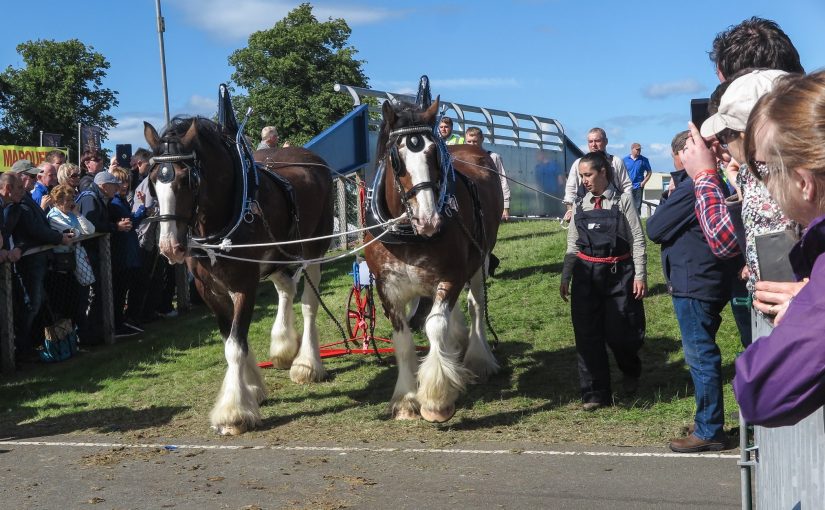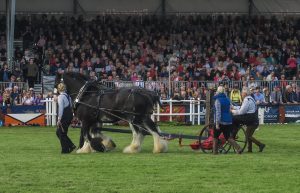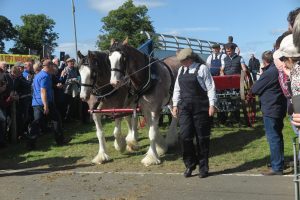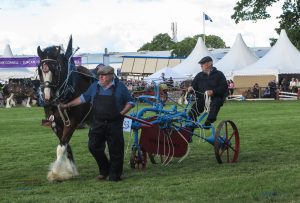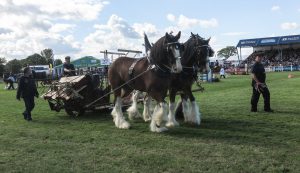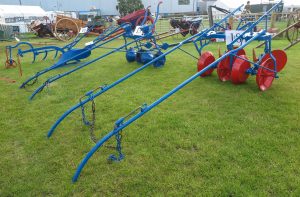The Highland Show of the Royal Highland and Agricultural Society of Scotland in 1872 was held at Kelso. It exhibited the latest implements and machines as well as some of the bread-and-butter ones that were widespread. This was the first time that the show had been in the district since 1863. Since that time there had been some significant developments in the making of agricultural implements and machines, not only in terms of their breadth, but also in new makers and the extent of their manufactures.
What was being exhibited at the show? The Kelso Chronicle provided a systematic account of the different types of exhibits (normally accounts noted what each stallholder had on their stand). This is a helpful account for being able to compare makers and their manufactures. Here is what the newspaper observed at the show:
“Agricultural implements
The implements in the exhibition numbered 1777, which was not equal to the three previous years at Edinburgh, Dumfries, and Perth, but largely in excess of any former year, and 676 more than at the Kelso show in 1863. Of these, however, a large proportion could be only by courtesy called agricultural implements; but of standard cultivators of the soil there was an excellent display, and the implements and machines were in general well adapted for the district.
Steam cultivators
Steam ploughs and cultivators have the first claim to notice. At the last Kelso show, Messrs Howard alone exhibited steam cultivators, having on the ground a complete set of apparatus, with a three furrow steam plough, which was claimed as a new invention. On the present occasion, there is exhibited a working model of Fisken’s patent steam-cultivating tackle; while Messrs John Fowler & Co., shows many different articles, most of them connected with steam cultivation; and a steam plough, price, £100, is shown by G. W. Murray & Co., Banff Foundry, Banff.
Common ploughs are shown by many eminent makers from various parts of the country. Among the exhibitors are-Messrs Jack & Sons, Maybole; James D. Allan & Sons, Dunkeld; Thomas Brown, Edington, Chirnside; Thomas Gray, Uddingston; John Gregory, Westoe, South Shields; Law, Duncan & Co., Shettleston; Lewis & Co., Shrewsbury; G. W. Murray & CO., Banff; T. Pirie & Co., Kinmundy, Mintlaw, Aberdeen; Reid & Co., Aberdeen; G. Sellar & Son, Huntly, Aberdeen; Thomas Thompson, Stobswoodfoot, Hawick, whose ploughs have carried off the premiums at many a Border ploughing match; and David Young, Hassington, who shows in all six articles of excellent workmanship.
There is also a good display of double-furrow ploughs, exhibited by Messrs Jack & Sons; John Pringle & Co., Kelso; Andrew Shiel, Coldstream; Richard Bickerton & Sons, Berwick; John Gray; John Gregory; R. Hornsby & Sons, Grantham; A. & J. Main & Co., Glasgow; G. W. Murray & Co.,: John Murray, Kilmarnock, who claims to have made a new invention; Thomas Pirie & Co; Thomas Reid, Monkton, Ayrshire; George Sellar & Son, Huntly; and John Fowler & Co. Messrs George Sellar & Son lay claim to a radical improvement in respect of the style of the skifes or sheats, which are found to be the weak points in these implements, when they come in collision with stones. The exhibitors state that they have tried skifes made of flat wrought iron bars, of malleable cast iron and of cast steel castings, and all in a measure have failed. The improved skifes are made of T wrought iron, and these have given satisfaction both at home and in the colonies. For a plough specially adapted for taking one furrow up and two down hill by a single movement of a small lever, the ploughman can have single or double furrow at pleasure. The same makers show another novelty in the shape of a combined common and subsoil plough, which during the past year has been found to answer the purpose admirably. By the use of this single and subsoil plough a saving is made of one man and one horse. The subsoiling part can be separated at pleasure, leaving the common plough complete and entire. The subsoiling part can also be fitted to almost any plough at a trifling expense. The whole of these ploughs are of very superior workmanship. The double furrow plough, shown by Mr Reid, also claims to be a new invention, the improvement being that he has a lever to regulate the depth of the front wheel, and the same lever acts so as to turn the plough easily, and to carry it easily over stones or other obstructions.
The show of grubbers is not very large; but some useful articles of this kind are exhibited by Jack & Sons; Thomas Brown; John Gray; Thomas Hunter; Kemp, Murray & Nicholson; Law, Duncan & Co; Ben Reid & Co.; T. Pirie & Co.; James Scott, Tweedmouth; and John Smail, Huntershall, whose grubber-harrow is shown as a new invention. There is likewise a good display of drill-grubbers, for cultivating between the rows of drilled turnips.
Harrows are shown in considerable variety-among the exhibitors being Jack &S Ons; Lillie & Elder; Mackay & Fairbairn, Sciennes Place, Edinburgh; John Pringle & Co; Andrew Shiel; John Gray; William Gray, Wishaw; John Gregory; Thomas Hunter; Main & Co; Pirie & Co; and Reid & Co.
Mr David Young, Hassington, shows a Norwegian harrow, the only one on the ground. This is a most useful article for retentive soils, and produces a finer mould than a combined application of roller and harrow. The action of the Norwegian harrow is a combination of the light grubber, roller, and harrow.
Rollers, pressers, and clod-crushers are fairly represented, among which is an improved consolidating land-roller, 6 feet wide by 30 inches in diameter, with self-lubricating grease boxes, made by Jack & Sons; two very good articles by Lillie & Elder; and others shown by John Pringle & Co., Allan & Sons, Thomas Hunter, Kemp, Murray & Nicolson, and Main & Co.
Of turnip sowers nine specimens are shown-one of them exhibited by William C. Caverhill, Berwick on Tweed, but made by W. Sawney; a useful combined mangold and turnip sower, with improved feeding boxes, by Jack & Sons; another of excellent qualities by Kemp, Murray & Nicholson; and improved two-row turnip and mangold sowing machine, by Thomas Sheriff & Co, West Barns, Dunbar, and two excellent articles from William Storie, Lanton, Jedburgh-one of them with indicator for regulating the seed, and one a combined turnip and mangold sowing machine, with graduated regulator. They are all shown by Scotch makers except the first.
Drill grubbers, drill harrows, drill ploughs, drill rollers, horse hoes, &c, are shown in considerable variety and at very moderate prices, showing how much has been done to facilitate turnip culture and abridge mere manual labour.
Reaping and mowing machines
Reaping and mowing machines are represented in great abundance and variety, all the local and district makers being in strong force. Mr Walter A. Wood, of London, shows six different specimens of his lights and manageable implements, which are much admired. Machines by the same maker are shown by Hooper & Company, Kelso, who have also implements of the same class, made by Samuelston & Co, and Picksley, Sims, & Co. Jack & Sons show their patent Buckeye combined reaping and mowing machines, which have long held a good reputation. Messrs Lawson & Son, George VI Bridge, Edinburgh, show five different articles of this class, four of which claim to be new inventions. There is, first, the Superior “Screw” mower, made by the Superior Machine Company, Virginia; next the superior Screw Mower, with reaping attachments, made by the Superior Machine Company, Virginia; the Screw Mower, made by the Screw Mower Company, New York; and two combined screw mowers and reapers, all of which are entered as new inventions. Messrs Little & Elder, Berwick, have four different implements, three of which are entered as new inventions, and the fourth as a radical improvement. A one-horse reaper and mower is shown by Mackay & Fairbairn. Mr Mollison, Kelso, shows two patent double-speed combined reaping and mowing machines, a new invention, which is much admired. The well-known form of Picksley, Sims & Co., exhibits six different implements; and two manual and self-acting back-delivery reapers are shown by Allan & Sons. Bickerton & Sons have five implements, showing improvements on their well-known Buckeye, Junior, and Excelsior machines. Brigham & Co., have six implements, which have acquired a good reputation in the district; and Thomas Brown, Edington, has a reaper with improved self-adjusting stay. Mr Dum, Kelso, shows Wray’s excellent little machines, for which he has the agency in Kelso; and several good implements are shown by Mr John Doe, Errol. George Gillis, Haydon Bridge, shows a lot of good implements, as also does John Gregory, and Haughton & Thompson, Carlisle. Mr Andrew Hogarth, Kelso, shows his excellent machines “The Border Chief”, “Kelso Eclipse”, “Tweedside Reaper and Mower”, and “Little Wonder Reaper”. The other exhibitors are-R. Hornsby& Sons; Kemp, Murray & Nicholson; Law, Duncan & Co; Lewis & Co; Main & Co; William Mattison; G. W. Murray & Co; G. & W. Porteous; Reid & Co; James Scott; Edwin Sherwood; and Thomas Halliday.
Horse rakes are shown in large variety, of which Hooper & Company, Kelso, shows three-one of them a new invention by Howcroft & McGregor, made by Picksley, Sims & Co. Two good implements are shown by Andrew Shiel, Coldstream; and among the other exhibitors are Bickerton & Sons; Brighton & Co., Gibson & Tait; John Gregory; Haughton & Thompson; Kemp, Murray & Nicholson; Law, Duncan & Co; Main & Co.; G. W. Murray & Co.; G. & W. Porteous; Reid & Co; and Jas Scott.
Thrashing machines are exhibited by G. W. Murray & Co., Hornsby & Sons, Robey & Co. (Lincoln), and Williamson Brothers (Kendal).
Traction engines-eight horse power and six horse power-re shown by John Fowler & Co.
Rick stands are shown by Mackay & Fairbairn; Gibson & Tait; Thomas Pearson & Co; and Thomas Halliday. Rick covers for corn and hay are shown by Mackay & Fairbairn; and by Mr John Unite, whose covering has been practically tested at the show: the sheds having been covered with canvas by him.
Fanners for dressing corn are exhibited by Penny & Co., Lincoln; Main & Co; James Miller, Haddington; G. W. Murray & Co.; John Richardson. Carlisle; Haughton & Thompson; Kemp, Murray & Nicholson; Reid & Co.; and William Sawney; and corn screens were shown by Penney & Co., John Pringle & Co., and Main & Co.
Of turnip cutters, cake breakers, and other articles for preparing food for stock there is, of course, great variety, and many of the specimens are excellent.
Wire-work fencing, which has now reached great perfection, is in great excellent at the stands of Wm C. Caverhill; John Gray; Hooper & Co; Mackay & Fairbairn; John Pringle & Co.; Gibson & Tait; A. & J, Main & Co.; G. W. Murray & Co.; and Ben Reid & Co.
Messrs Henderson & Son, plumbers, Kelso, had an extensive stand, comprising many useful articles in connection with framing, especially in cattle feeding troughs. They have also the honour of supplying the ornamental bronze drinking fountain, for which they were awarded a medium silver medal.
Mr Sinton, Jedburgh, has a lot of above forty of his excellent churns, which have now taken the premium at many a show, and only last week secured further honours at the Royal Northern Society’s Show at Aberdeen. They are of excellent workmanship, and on a principle that combines efficient operation with easy working. Mr James Eastwood, Blackburn, exhibits a lot of churns of his own make, which have had a great success in this country and in Ireland. They are of a peculiar construction, and seem to be very useful articles.”
Do you recognise any of the names at the Show?
